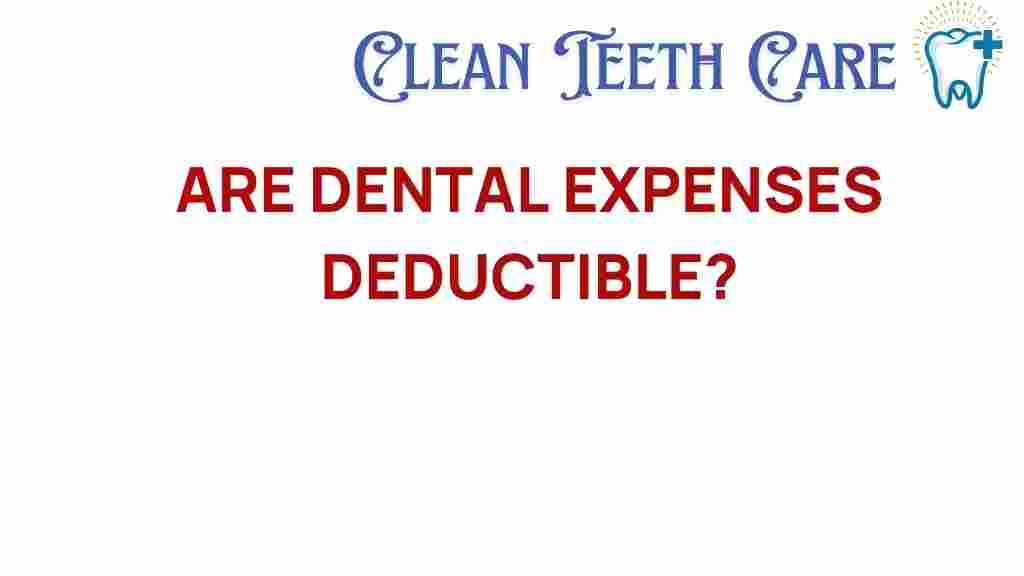Unraveling the Mystery: Are Dental Expenses Deductible?
When it comes to managing healthcare costs, understanding the intricacies of tax deductions can be a daunting task. One area that often raises questions is whether dental expenses qualify for tax deductions. If you’ve ever wondered how to maximize your financial planning with respect to dental care, you’re not alone. In this article, we will delve into the IRS guidelines regarding dental expenses, explore what qualifies for deductions, and offer tips on how to effectively manage your taxes related to dental care.
Understanding Dental Expenses and Their Tax Implications
Dental expenses can encompass a wide range of services, from routine cleanings to major surgical procedures. For many taxpayers, the question of whether these expenses are deductible hinges on their total healthcare costs and how they are classified under the tax code.
The IRS allows taxpayers to deduct certain medical and dental expenses, but there are specific criteria that must be met. To understand if and how you can benefit from these tax benefits, it is essential to familiarize yourself with the relevant IRS guidelines.
What Are Deductible Dental Expenses?
According to IRS guidelines, the following types of dental expenses are generally considered deductible:
- Preventive care (e.g., cleanings, check-ups)
- Restorative procedures (e.g., fillings, crowns)
- Orthodontics (e.g., braces)
- Oral surgery (e.g., tooth extractions, jaw surgery)
- Dentures and other prosthetic devices
It is crucial to keep track of all your dental expenses throughout the year, as they can add up quickly. The IRS allows you to deduct dental expenses that exceed 7.5% of your adjusted gross income (AGI) if you itemize your deductions.
Step-by-Step Process to Claim Dental Expense Deductions
To take advantage of tax deductions for your dental expenses, follow these steps:
Step 1: Gather Your Records
Start by collecting all relevant documents, including:
- Receipts for dental treatments
- Insurance statements showing what was covered
- Records of payments made out-of-pocket
Step 2: Calculate Your Total Dental Expenses
Add up all the dental expenses you incurred during the tax year. Make sure to include only those that were not reimbursed by insurance.
Step 3: Determine Your Adjusted Gross Income (AGI)
Your AGI is your total income minus specific deductions. You can find this on your tax return form. Once you have your AGI, calculate 7.5% of this amount.
Step 4: Compare and Calculate Your Deduction
Subtract the 7.5% of your AGI from your total dental expenses. The remaining amount is what you can potentially deduct on your tax return if you itemize your deductions.
Step 5: File Your Taxes
Use Schedule A (Form 1040) to report your itemized deductions, including your dental expenses. Be sure to keep all documentation for your records.
Common Questions and Troubleshooting Tips
When navigating the world of tax deductions for dental expenses, you may encounter some common questions:
Are cosmetic dental procedures deductible?
Generally, cosmetic procedures are not deductible unless they are deemed necessary for medical reasons (e.g., a jaw alignment issue that requires a surgical procedure).
If you pay for dental insurance, those premiums can also be included in your total medical expenses when calculating your deduction.
What if I’m self-employed?
Self-employed individuals can deduct their dental insurance premiums as a business expense, but they should also keep all other records of dental expenses that may apply.
What if I exceed the 7.5% AGI threshold?
If your dental expenses exceed the 7.5% threshold, you can deduct that excess amount, provided you are itemizing deductions.
For further assistance with tax-related questions, consider consulting a tax professional or visiting the IRS website for the most current guidelines.
Effective Financial Planning for Dental Expenses
Managing healthcare costs related to dental care requires proactive financial planning. Here are some strategies to consider:
- Health Savings Accounts (HSAs): Contributing to an HSA can help you save money tax-free for qualifying medical expenses, including dental care.
- Flexible Spending Accounts (FSAs): FSAs allow you to set aside pre-tax dollars for medical expenses, which can include dental expenses.
- Insurance Plans: Ensure that your dental insurance plan covers the services you are likely to need and understand the limits of your coverage.
- Payment Plans: Some dental offices offer payment plans for expensive treatments. This can help you spread the cost over time.
By planning ahead and understanding the potential tax benefits, you can minimize your financial burden when it comes to dental care.
Conclusion
In conclusion, dental expenses can indeed be deductible under certain circumstances according to IRS guidelines. By familiarizing yourself with what qualifies, keeping thorough records, and utilizing the appropriate tax forms, you can maximize your potential deductions. Moreover, incorporating financial planning strategies can help mitigate the costs of dental care over the long term.
Always remember to stay informed about changing tax laws and consider consulting with a financial advisor or tax professional to optimize your personal finance strategy. For further reading on managing healthcare costs, check out this helpful guide.
This article is in the category Treatments and created by CleanTeethCare Team
